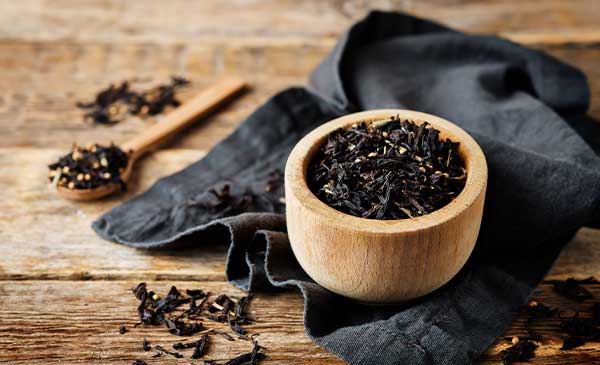The Ultimate Guide to the Best Black Tea

In 2023, Americans consumed more than 4 billion gallons of tea with about 86% of that being black tea.
As one of the most popular types of teas in the world, how do you know which of the black teas is right for you? This guide to the best black tea will help you learn about the origin, flavor profiles, as well as the health benefits.
What is Black Tea?
Black tea originated in China in the 17th century. Today the three largest producers are India, Sri Lanka, and Africa. Half of the world's production of black tea actually comes from India now instead of China.
The varying geography and climate of these countries produce diverse black tea varieties, cultivars, and flavor profiles. People love good black tea for its strong flavors, dark amber color, and robust texture.
Chinese teas are softer, fragrant, and less astringent than tea from other countries. This is because China withers and oxidizes the leaves at a slower pace.

How are Black Teas Made?
After workers harvest the leaves, they sort them by grade, separating out the best quality for loose leaf tea. (Tea bags get the leftovers if you get where I'm heading.)
Traditionally, the workers withered the leaves in natural sunlight for 10 to 14 hours. Today, they complete this process indoors. This allows the tea master to control air temperature, humidity, and circulation. This is essential to the final flavor of the tea.
After withering, the leaves are rolled. This process breaks the cell wall of the leaf releasing enzymes and essential oils.
The next step is oxidation. This phase develops the flavor, aroma, and strength of black tea. The leaves are spread out to rest for up to eight hours. During this time they change from pale green to a golden brown.
To halt the oxidation, the fresh black tea leaves are then placed under heat for 20-35 minutes. Thus locking in the desired characteristics of the tea.

Most Popular Varieties of Black Tea
Where the tea originates, and the tea master's techniques determine the traits of each black tea.
With more tannins than other teas, the flavor of black tea is stronger. But black teas can also provide sweet notes. High-quality black teas express a rich, complex flavor that goes well with a drop of milk.
Assam Black Tea
Assam is a low elevation region in northeastern India. The malty, strong flavor of Assam black tea is often attributed to the warm, wet growing climate.
Assam tea is a perfect breakfast tea with its slightly higher caffeine content. Initial sips may display astringent or tannic characteristics, but the roasted malt and creaminess produce a smooth, creamy finish.
Ceylon Black Tea
In the late 1800s, tea was planted in Ceylon (now known as Sri Lanka) to replace a waning coffee industry. The British were importing vast amounts of Assam seeds to the island and Ceylon emerged as the world's leading tea exporter by 1965. Of all the tea produced in Sri Lanka, Ceylon is more popular than its green and white teas.
Irish Breakfast is a blend of Ceylon and Assam black tea giving it an intense robust flavor. It has a spicy and jammy aroma, malty flavor, brisk mouthfeel, and nice sweetness in the finish.
Ceylon tea is often used in black tea blends:
- Cinnamon Spice is an aromatic black tea blend with the spicy, crisp finish of orange and cloves.
- Raspberry Black tea is a gourmet black Ceylon tea blended with sweetly tart and jammy raspberries. This cup has well balanced astringency with a sweet, slightly dry finish.
- French Vanilla Tea has the sweet aroma of fresh vanilla beans. This flavored black tea steeps to a beautiful amber color with a full-bodied flavor that mellows with each sip.
- Chocolate Chai is a chocolate lover's dream come true. Ceylon black tea is blended with cocoa nibs, cardamom, ginger, cloves, and cinnamon. It's like dessert with a kick.

Chai
Chai is a blend of tea with sweet and warming spices such as cardamom, cinnamon, cloves, black pepper, and ginger. It is often enjoyed in lattes.
Masala chai is an Assam tea blend with cinnamon, ginger, clove, anise, coriander, and cardamom.
But chai isn't always referring to black tea. Chai can also be found as a green or white tea blend, or even rooibos.
Darjeeling Black Tea
Darjeeling black tea comes exclusively from a small region nestled in the foothills of the Himalayas. The tea grows slowly at this higher elevation and compared to other regions. The lack of abundance of Darjeeling produced makes it one of the world's most expensive teas. Tea lovers often referred to as the "champagne of tea".
People enjoy Darjeeling tea for its floral and muscatel flavor. Some add a drizzle of honey, but it is best served without milk or sugar added.
Darjeeling teas are harvested in four flushes throughout the year. The first flush Darjeeling is revered as it provides the freshest and fragrant teas being the first pluckings of the season. However, many black tea connoisseurs prefer the flavors of the second flush.
Earl Grey
Earl Grey is considered a flavored tea as it is either an Assam or Darjeeling tea that has been infused with bergamot oil. The bergamot citrus from southern Italy creates a fusion of orange and lemon flavor. The addition of vanilla in Earl Grey Creme softens the edge of the citrus notes.
Lavender Earl Grey is a twist on the classic Earl Grey. It offers the sweet, floral fragrance of lavender creating a soothing, relaxing cup of tea.
Golden Monkey
Golden Monkey tea (also known as Orange Pekoe tea) considered one of the finest black teas from the Fujian province of China. As the tea cools, the full-bodied flavor transforms from a malty and slightly sweet to the flavor of roasted apples, walnut, cocoa, and spice. Each cherished sip finishes with a hint of smoke.
Irish Breakfast Tea
Irish Breakfast tea is a blend of several black teas, most often Assam and Ceylon tea. It is one of the most popular blended black teas and commonly enjoyed with milk, sugar, or even honey. The stronger Assam component creates a more robust, malty flavor and reddish color.
Keemun Black Tea
English Breakfast tea is made from high-quality Keemun tea leaves. This tea has a rich, slightly smoky flavor and perfectly balanced astringency with a distinctively sweet aroma. Tea lovers savor this black English Breakfast tea as is or with a splash of milk.
Lapsang Souchong
This black tea from Fujian province is produced from the larger, leaves plucked lower on the plant. Instead of oxidizing in the sun, Lapsang Souchong leaves are dried over an open fire. Typically this is a pinewood fire creating its famous smoky flavor.
Yunnan
Yunnan originates from the province in China. Some Yunnan black teas are partially fermented, meaning that they fall between black tea and Pu-erh. Yunnan flavors are typically chocolaty, dark, and malty, with notes of spice or sweetness. Chocolate lovers tend to love Yunnan tea.
How To Enjoy Black Tea
Black tea is a very versatile tea that is enjoyed hot or iced tea. To mellow the taste, black tea drinkers often add milk, lemon, honey or sugar. But many prefer their black tea just plain. There are no rules.
The best quality black tea provides a good shelf life, retaining the distinct flavor for several years. The flavor of black tea can be stronger and more astringent than other tea. However, when brewed correctly black tea should be smooth and flavorful.
Brewing black vs green tea
Although they both originate from the same tea plant, there are many differences between black and green tea. To fully appreciate the flavor of loose leaf black tea, the brewing process is important.
While green tea can turn bitter at higher temperatures, black tea is best steeped at 195-200F.
Allow the tea to steep in the hot water for three to five minutes. For more boldness and caffeine, black tea can be steeped for a longer period. Adding to the steep times will result in a darker color without added bitterness.
What are the Benefits of Black Tea?
Studies have shown that the high antioxidant content of black tea may provide several health benefits:
- Lowering "bad" LDL cholesterol
- Improving gut health
- Decreasing blood pressure
- Boosting heart health
- Reducing the risk of stroke
- Lowering blood sugar
- Improving focus
- Helping protect against the risk of Type2 diabetes

How Much Caffeine is in a cup of Black Tea?
Harvested from the Camellia sinensis plant, black tea is considered a true tea. All tea from this plant contain caffeine, with black tea being the most caffeinated of the true teas.
The amount of caffeine in an 8-ounce cup of black tea is about 47 mg. Compare this to 95 mg of caffeine in an average cup of coffee.
The level of caffeine in black tea can vary depending on three factors:
- Water temperature
- Brewing time
- Ratio of leaves to water
Hotter water, longer brewing time, and more tea leaves mean more caffeine in your cup.
While you can't find caffeine-free black tea, there are decaffeinated black teas available. Learn about the difference between caffeine-free and decaffeinated tea.
If you are switching over from coffee, but want to maintain your caffeine intake, brewed black tea is a good option for you.
SOURCES
https://www.healthline.com/nutrition/black-tea-benefits






